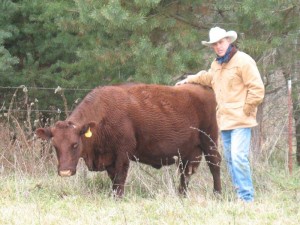Addendum…..
….or should that be addenda? Addendae?
Anyway, here’s more on managing heifers growing out of our Roundtable below. Both Bill Roberts and Juliet Cleave have posted comments along the way the past several days but I thought these two were worthy of special attention so I brought them up here.
If you haven’t seen Juliet’s video, I hope you’ll do so now. Turn up the sound.
 First, to re-introduce Juliet. She’s one of our partners in the Traditional Devon project in England. A native of Cornwall, living and raising Devon on land her family has farmed for well over 100 years. She has a spectacular herd and it was a video she made that started this discussion about heifers.
First, to re-introduce Juliet. She’s one of our partners in the Traditional Devon project in England. A native of Cornwall, living and raising Devon on land her family has farmed for well over 100 years. She has a spectacular herd and it was a video she made that started this discussion about heifers.
Here’s her latest contribution:
In the Kew Herd, & throughout most of British Devons, we aim for a moderate birthweight (or even small) for easy calving, but combined with the bloodlines that provide (a) growthy genetics & (b) a milky line in the dam = calf pops out then grows like a bushfire! But this you already know; the interesting part is that we have just sold a senior Devon bull into a large continental breed farm (400 Charolais & Belgium Blue cows) as they were despairing at the number of caesareans they were doing (10% last calving season). By chance, the (human) daughter of the establishment, was so taken up with the Devon breed, she’s gone out & bought some Devon heifers!
Remember also that the Devon breed has a slightly shorter gestation period than a lot of other breeds – which is of course a bonus when using the Devon bull as a terminal sire (cross breeding): calf pops out ‘early’ before it gets too big.
Management (feeding) also a major factor: unborn calf growth is 75% during last 2 months of gestation – so must ensure cow has intake to produce healthy calf plus that all important colostrum (we call it ‘buzzy milk’), yet be in working condition in herself for calving. Marvellous: another tightrope the stockman has to walk! Nothing new here either, but those minerals have to be balanced (if you’ve had a wet year, have the trace elements been leached out of the forage/hay?)
So here’s my answer to your question: YES! The Devon is all about a moderate framed cow, in moderate condition, producing low birthweight calves that rapidly grow to maturity on low inputs. This is the description of the Devon breed in a nutshell (re You Tube video ‘you can have it all with the Devon’!)
Management (& choice of bloodlines) is the name of the game. In the UK, EBVs (Estimated Breeding Values from Breedplan or Signet) are the recognised way of evaluating birth weights/growth rates etc, while some folk do their own recording without being affiliated to an independent program. The Devon breed society in each country will have a preferred scheme for these schemes, so as many members as possible use the same scheme as the figures are most meaningful when compared to maximum headage within a breed (doesn’t relate to figures in another breed).
Bill Roberts of 12 Stones Grasslands Beef is a 
ranch consultant, aggregates grass fed cattle for several companies, and sells a variety of livestock health products under his own label. A friend and colleague for some time, we served together for a number of years on the board of the North American Devon Association. Here’s his latest input on the heifer discussion:
The depth of the thought processes manifested in Edward’s comment are excellent and far reaching. I will try to answer with a broad brush that has specifics within it.
First, in the case of registered Devon and other breeds, there are breed standards that members of the associations have established as “right for the breed.” From a seed stock perspective, staying true to type is important and is an easy road map to follow. Simply select for cattle that fit the standard model in all phases of the growth cycle.
Commercial producers are the mavericks who want to tailor-make their breeding program to what their unique circumstances need based on known factors. For instance: a steer will usually finish within about 100 pounds of the cow’s mature weight in good flesh. That being a known, one can tailor their fat cattle production finished weight by the cows they come from. The bull does contribute but the rule seems to generally apply. So end weights can be predictable.
Now comes the nuances of our discussion. How are birth weight and growth rate predicted to get to the end weight and how can it be manipulated through management practices? Aside from breed standards, the commercial producers rule of thumb is that “a live calf is better than a dead one.” Therefore, large commercial breeders use EPD’s on the bulls used to predict birth weight which is a highly heritable trait. They use bulls that produce light calves on heifers and young cows, hence the name “heifer bulls.” And they use bulls that produce heavier calves to produce calves that are “jump started” on growth from easy calving older cows. Hence the name, “terminal bulls.” While this is common practice in commercial herds, it can cause havoc in purebred herds. What if a breeder buys a purebred bull that has genetics to produce 95 pound calves consistently and he does not know it? Trouble is on the way. That is why with our Devons, we only propagate bulls that consistently produce 55 to 75 pound calves that then grow like weeds once they hit the ground. Finding those cattle takes time, selection and culling ruthlessly. Those kind of bulls are in most breeds but need identified.
We used to be on the Board of the Great Western Beef Expo in Sterling, Colorado. It was a feedlot and carcass evaluation center for a multiplicity of breeds wanting to demonstrate their breeds ability in those areas. We worked with several Salers breeders. Those cattle would be born at very light weights and come out shaped like a missile. They were easy calvers par excellance. Once on the ground, they grew at an amazing rate. That model is available to emulate in most breeds through selection.
Once a live calf is on the ground, selecting for growth rate becomes the breeder’s mission. That growth rate has to be aligned with their management style, i.e. conventional grain fed, grass fed, etc.. Cattle that respond to the conditions they are in will manifest as right for their environment by being average, below average or above average compared to their herd mates in the same environment. Good growthy cattle that grow rapidly, get to breeding weight rapidly, breed effectively and keep gaining and growing (if the feed is adequate in quantity and quality) even through pregnancy are optimal cattle. These kind of cattle that can truly perform on typical forages across the US are not in oversupply. Endeavors like those of the Brits I met who select based on perennial rye grass environments and folks like the Traditional Devon folks do in the US, are improving the opportunity to access those kind of cattle. As these kind of cattle become more abundant and we get the soils and forages better than most chemically dependent US soils can produce right now, we will see this all fall in to place.
Finally, yes – if through MIG or mob grazing one’s cost of production are less, it stands to reason one can wait and breed heifers at 24 months and “be easier on them” for longevity. Most commercial producers do not have that option. Their banker is waiting for his money. So in cattle country in the west, they calve in April/May and then those replacement heifers have to breed back in July/August of the following year at around 15 months of age to stay in the program. Heifers are generally preg checked in the fall and culled from the herd if they did not conceive. Economics do not allow a free loader to go through the winter on high priced hay if she is not going to produce a return on investment in the following spring.